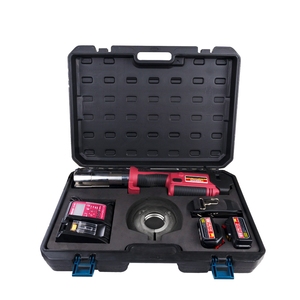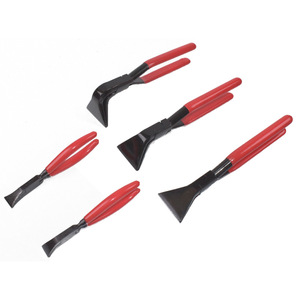
All categories
Featured selections
Trade Assurance
Buyer Central
Help Center
Get the app
Become a supplier

(1441 products available)


































Sheet metal crimping tools are available to buyers in various configurations. Each of these types is suited to the specific needs of the job at hand.
Further breaking down into hand-held and lever-operated models, manual crimping tools are designed to execute small- or medium-scale operations. These tools necessitate human power to generate the crimping force. They are mostly recommended for jobs requiring light to moderate usage. In addition, they are prized for their ease of handling and low maintenance.
Powered crimping tools are mostly electric or hydraulic tools. These tools are often used in large production settings. They automate the crimping process. As a result, they offer improved speed and efficiency over manual models. In addition, these tools are highly recommended when used for large volumes of heavy-gauge materials.
Specific applications crimping tools include former, corner, and seam crimpers. They are often specialized for very specific metalwork tasks. These tools are targeted at creating particular types of crimps. These types of crimps include those that are often needed in ductwork or roofing projects. Although they are designed for highly specialized work, these tools are advantageous because they often provide more detail and precision than general crimping tools.
In conclusion, sheet metal crimping tools come in manual and powered configurations. Specific application crimping tools are available for users to choose from based on their project's needs. Understanding the differences between these tools helps users select the right equipment to ensure they get the best results for their metalworking projects.
The primary function of a sheet metal crimping tool, as the name implies, is to deform the edges of metal sheets. This deformation enables the edges to interconnect securely with other metal sheets. In doing so, it enhances the durability and stability of the resultant structure.
Many sheet metals are utilized in HVAC ducting systems, automotive bodywork, and metal roofing. Some of the common types of crimps that metal crimping tools create include folds, ridges, and grooves. These features offer a tight seal and prevent any leakage or wastage of space, as is often experienced in most metalwork applications.
Despite their diverse designs and operational features, most crimping tools have common features. These features help them effectively carry out their function. Key inclusions are the type of crimp required, the power source (for the powered tools), and the material compatibility (which is especially critical in determining the tool's lifespan). The ease of adjustment and ergonomics are other features that need to be factored in.
The other feature to consider in commercial-grade tools is their robustness and construction, as they are expected to execute heavy-duty works. Finally, those tools intended for specific applications often come with additional features that improve their workability, such as interchangeable dies.
A crimping tool's design is also very important as it impacts functionality and user-friendliness. For instance, manual tools often have ergonomic handles to reduce fatigue when they are being operated for long. The dies' shape and configuration are other relevant design features. They determine the types of crimps the tool can create.
The design also affects the tool's ease of use, especially for powered models, which involve complex operations. These tools often have to be connected to power supplies. The compactness of the design is also crucial when one strives for portability or storage. Therefore, a well-thought-out design ensures that a sheet metal tools kit is as effective as it is user-friendly and convenient.
So where do these sheet metal crimpers come in handy? The answer is they are used in various applications. The most common application is in HVAC installations where ducting is made of sheet metal. Here, crimping helps to fit the ducts snugly within ceilings, walls, and floors for proper air circulation. Also, in roofing projects, crimping tools fold and compress metal to create the necessary interlocking joints. This crimping ensures the roof is leak-proof and weather-resistant.
Automotive industries also have applications for crimping tools. They are there to provide other essential functions, such as bodywork assembly. In these projects, crimping is used to join metal sheets so that the finished structure will be lightweight but still strong enough to withstand the elements. Moreover, crimping tools are also applied in equipment enclosures and metal cabinets, which are common in electrical and mechanical industries, to ensure that the covers fit tightly.
Thus, crimping tools are indispensable in any metalworking-related business. They assist in achieving safe and efficient metal joints in construction, automotive, and manufacturing industries. The paper further provides specific guidance on which crimping tools are best employed for varying industry needs. The guidelines consider efficiency, ease of application, and the nature of the metalwork.
Several factors should be considered if buyers wish to select the most suitable sheet metal crimping tool for themselves. First, buyers should determine the nature of the metalwork project. Manual tools can do small and less intense jobs. Powered crimpers should do larger, more extensive, or repetitive jobs. Next, it is also important to consider the tool's material and build quality. After all, durable materials are more likely to ensure that the tool endures extended workloads.
Buyers should also look for models with multiple dies or adjustable settings. Such models are ideal since they can easily be adapted to different crimping shapes or sizes. It only makes sense, as the more versatile the tool, the more convenient it is for diverse applications. Lastly, the tool's power source should also be a key consideration. For example, hydraulic tools offer more power than pneumatic ones. However, one must consider that electric tools may be more convenient in most simpler workshops.
These guidelines enable buyers to narrow the options down to the most suitable sheet metal crimping tools and avoid making the wrong choice amid the numerous available options.
A.1 Manual tools require human effort, while powered tools.
A.2 There are tools for thin and heavy metals.
A.3 Specialized tools are needed for specific tasks.
A.4 It is vital, especially for long-term use.
A.5 They are used in HVAC, automotive, and construction industries.